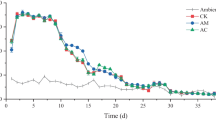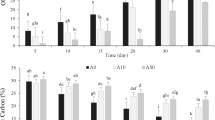Abstract
Oxytetracycline (OCT) is a broad-spectrum antibiotic commonly used for broiler production to enhance growth and feeding efficacy. Concern has been expressed that the parent compounds of antibiotics such as OCT or their bioactive metabolites may be excreted through animal feces or urine with negative consequences for the environment when applied to agricultural lands. An integrated system involving a combination of thermophilic composting and vermicomposting using Eisenia fetida was investigated as a strategy for reducing the concentrations of oxytetracycline and its metabolites (4-epi-oxytetracycline [EOTC], α-apo-oxytetracycline [α-Apo-OTC] and β-apo-oxytetracycline [β-Apo-OTC]) in chicken manure. Treatments consisted of combinations of chicken manure and waste paper to produce waste mixtures with C: N ratios of 20, 30, 40, 50, 60 and 70 (T1, T2, T3, T4, T5 and T6, respectively). These were subjected to thermophilic composting for 20 days followed by vermicomposting with E. fetida for 7 weeks. The oxytetracycline concentration at the start of the experiment was in the range of 123.3–35.2 mg/kg, which reduced to 44–25.3 mg/kg after the thermophilic composting, and further reduced to 35.4–20.7 mg/kg at the end of the vermicomposting stage. The maximum overall percentage reduction of residual oxytetracycline in the final product was recorded in T3 (C:N ratio 40). The maximum percentage reduction of 84.3% was recorded in C: N ratio of 40 (T3) in which the metabolite degradation products were reduced to 3.1 mg/kg of 4-epi-oxytetracycline (EOTC), 3.9 mg/kg of α-apo-oxytetracycline (α-Apo-OTC) and 4 mg/kg of β-apo-oxytetracycline (β-Apo-OTC).




Similar content being viewed by others
References
Awad YM, Kim KR, Kim SC, Kim K, Lee SR, Lee SS, Ok YS (2015) Monitoring antibiotic residues and corresponding antibiotic resistance genes in an agroecosystem. J Chem. doi:10.1155/2015/974843
Dolliver H, Gupta S, Noll S (2008) Antibiotic degradation during manure composting. J Environ Qual 37:1245–1253
Engelhardt I, Sittig S, Simůnek J, Groeneweg J, Pütz T, Vereecken H (2015) Fate of the antibiotic sulfadiazine in natural soils: experimental and numerical investigations. J Contam Hydrol 177:30–42
Ghosh S, Ow LF, Wilson B (2015) Influence of biochar and compost on soil properties and tree growth in a tropical urban environment. Int J Environ Sci Technol 12:1303–1310
Hanc A, Vasak F (2015) Processing separated digestate by vermicomposting technology using earthworms of the genus Eisenia. Int J Environ Sci Technol 12:1183–1190
Hu XG, Zhou QX, Luo Y (2010) Occurrence and source analysis of typical veterinary antibiotics in manure, soil, vegetables and groundwater from organic vegetable bases, northern China. Environ Pollut 158:2992–2998
Iqbal MK, Nadeem A, Sherazi F, Khan R (2015) Optimization of process parameters for kitchen waste composting by response surface methodology. Int J Environ Sci Technol 12(5):1759–1768
Jordaan JD (2004) The influence of bedding material and collecting period on the feeding value of broiler and layer litter. M.Sc. Thesis, University of Free State, South Africa
Kim KR, Owens G, Ok YS, Park WK, Lee DB, Kwon SI (2012) Decline in extractable antibiotics in manure-based composts during composting. Waste Manag 32:110–116
Lim SL, Wu TY (2016) Characterization of matured vermicompost derived from valorization of palm oil mill byproduct. J Agric Food Chem 64(8):1761–1769
Lim PN, Wu TY, Sim EYS, Lim SL (2011) The potential reuse of soybean husk as feedstock of Eudrilus eugeniae in vermicomposting. J Sci Food Agric 91(14):2637–2642
Lim SL, Wu TY, Clarke C (2014) Treatment and biotransformation of highly polluted agro-industrial wastewater from a palm oil mill into vermicompost using earthworms. J Agric Food Chem 62(3):691–698
Lim SL, Wu TY, Lim PN, Shak KPY (2015) The use of vermicompost in organic farming: overview, effects on soil and economics. J Sci Food Agric 95(6):1143–1156
Lim SL, Lee LH, Wu TY (2016) Sustainability of using composting and vermicomposting technologies for organic solid waste biotransformation: recent overview, greenhouse gases emissions and economic analysis. J Clean Prod 111:262–278
Liu B, Li Y, Zhang X, Feng C, Gao M, Shen Q (2014) Effects of composting process on the dissipation of extractable sulfonamides in swine manure. Bioresour Technol 25(175C):284–290. doi:10.1016/j.biortech.2014
Loke ML, Jespersen S, Vreeken R, Halling-Sørensen B, Tjørnelund J (2003) Determination of oxytetracycline and its degradation products by high-performance liquid chromatography–tandem mass spectrometry in manure-containing anaerobic test systems. J Chromatogr B 783(1):11–23
Mupondi LT, Mnkeni PNS, Muchaonyerwa P (2010) Effectiveness of combined thermophilic composting and vermicomposting on biodegradation and sanitization of mixtures of dairy manure and waste paper. Afr J Biotechnol 9(30):4754–4763
Ndegwa PM, Thompson SA, Das KC (2000) Effects of stocking density and feeding rate on vermicomposting of biosolids. Bioresour Technol 71:5–12
Nelson KL, Brözel VS, Gibson SA, Thaler R, Clay SA (2011) Influence of manure from pigs fed chlortetracycline as growth promotant on soil microbial community structure. World J Microbiol Biotechnol 27:659–668
Ravindran B, Mnkeni PNS (2016) Bio-optimization of the carbon-to-nitrogen ratio for efficient vermicomposting of chicken manure and waste paper using Eisenia fetida. Environ Sci Pollut Res. 23(17):16965–16976
Ravindran B, Contreras-Ramos SM, Wong JWC, Selvam A, Sekaran G (2014) Nutrient and enzymatic changes of hydrolysed tannery solid waste treated with epigeic earthworm Eudrilus eugeniae and phytotoxicity assessment on selected commercial crops. Environ Sci Pollut Res 21(1):641–651
Selvam A, Xu D, Zhao Z, Wong JWC (2012) Fate of tetracycline, sulfonamide and fluoroquinolone resistance genes and the changes in bacterial diversity during composting of swine manure. Bioresour Technol 126:383–390
Shafrir M, Avisar D (2012) Development method for extracting and analyzing antibiotic and hormone residues from treated wastewater sludge and composted biosolids. Water Air Soil Pollut 223:2571–2587
Shak KPY, Wu TY, Lim SL, Lee CA (2014) Sustainable reuse of rice residues as feedstocks in vermicomposting for organic fertilizer production. Environ Sci Pollut Res 21(2):1349–1359
Song C, Li M, Jia X, Wei Z, Zhao Y, Xi B, Zhu C, Liu D (2014) Comparison of bacterial community structure and dynamics during the thermophilic composting of different types of solid wastes: anaerobic digestion residue, pig manure and chicken manure. Microbiol Biotechnol 7:424–433
Tzeng TW, Liu YT, Deng Y, Hsieh YC, Tan CC, Wang SL, Huang ST, Tzou YM (2016) Removal of sulfamethazine antibiotics using cow manure-based carbon adsorbents. Int J Environ Sci Technol 13:973–984
Varma SV, Kalamdhad AS (2015) Evolution of chemical and biological characterization during thermophilic composting of vegetable waste using rotary drum composter. Int J Environ Sci Technol 12:2015–2024
Wu X, Wei Y, Zheng J, Zhao X, Zhong W (2011) The behavior of tetracyclines and their degradation products during swine manure composting. Bioresour Technol 102:5924–5931
Wu TY, Lim SL, Lim PN, Shak KPY (2014) Biotransformation of biodegradable solid wastes into organic fertilizers using composting or/and Vermicomposting. Chem Eng Trans 39:1579–1584
Zhang Z, Shen J, Wang H, Liu M, Wu L, Ping F, He Q, Li H, Zheng C, Xu X (2014) Attenuation of veterinary antibiotics in full-scale vermicomposting of swine manure via the housefly larvae (Musca domestica). Sci Rep 4:6844
Acknowledgements
The study was financed through a postdoctoral fellowship to Dr. B. Ravindran by the Govan Mbeki Research and Development Centre (GMDRC) of the University of Fort Hare, and running expenses were provided by the National Research Foundation (NRF) through its Incentive Funding to Rated Scientists given to Prof. PNS Mnkeni. The authors are grateful to Dr Hupenyu Mupambwa for his assistance with some aspects of the study.
Author information
Authors and Affiliations
Corresponding author
Additional information
Editorial responsibility: M. Abbaspour.
Electronic supplementary material
Below is the link to the electronic supplementary material.
Rights and permissions
About this article
Cite this article
Ravindran, B., Mnkeni, P.N.S. Identification and fate of antibiotic residue degradation during composting and vermicomposting of chicken manure. Int. J. Environ. Sci. Technol. 14, 263–270 (2017). https://doi.org/10.1007/s13762-016-1131-z
Received:
Revised:
Accepted:
Published:
Issue Date:
DOI: https://doi.org/10.1007/s13762-016-1131-z




